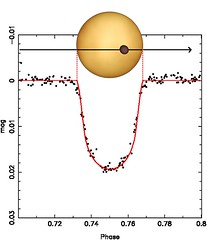
MOST satellite detects planetary transit.
Originally uploaded by Astro Guy.
I'm in the middle of finishing a paper on the albedo measurements of an extrasolar planet; HD 209458b. I've been playing with the data for about 6 months. I'm reaching the point of blind hatred. I'll feel much better once I finish the draft of my paper.
I gave talk in Calgary about the work I've been doing on this system, which includes full photometric reductions of about 500 000 CCD frames and fitting for the albedo. The albedo of the planet can be detected by watching the contributed light from the planet change during the orbital cycle. So I watch the planet change phases. It is brightest when fully illuminated by the star (like the full moon) and dimmest when looking at the night side (like a new moon). The planet as transits (goes in front) and is eclipsed (goes behind) its parent star. The transit causes a 2% dip on the light curve as seen in the figure above. The eclipse depth is equal to the amplitude light variations caused by phase changes, which is about 1/20000. So we need stable photometry better than 0.05 mmag over 40+ days of photometry. This can only be done from space.
As I switch from data-reduction monkey mode into paper writing mode, my blogs will entail my writing experience and how progress is going.
No comments:
Post a Comment